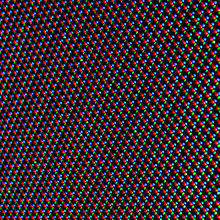MicroLED

MicroLED - also known as MikroLED , MLED , mLED or μLED - is a flat screen technology based on light emitting diodes (LED). As the name implies, MikroLEDs based on arrangements ( arrays ) microscopically small light Radiating diodes ( L ight E mitting D iodes, abbreviated LED s), the individual picture elements ( pixels ) form.
Advantages over other screen technologies
Compared to the older liquid-crystal displays ( liquid crystal displays, short LCDs) offer MICROLED displays a much higher contrast and lower black level, much faster response times , much better color rendering , higher efficiency with respect to light output per power and better viewing angle.
MicroLEDs are considered the successor to organic light-emitting diodes (OLEDs). MicroLED displays currently (2018) have four decisive advantages over OLED displays: Longer service life, no burn-in effects, greater brightness in new devices and brightness that does not decrease significantly over time. In contrast to OLEDs, which consist of organic molecules, MicroLEDs consist of indium gallium nitride InGaN. Inorganic semiconductors based on MicroLEDs were first developed by a research group led by Hongxing Jiang and Jingyu Lin from Texas Tech University in 2000.
Commercial use
Due to their low energy consumption, MicroLEDs are suitable for both very small (such as smartwatches and smartphones ) and very large displays (such as giant television screens, e.g. in stadiums or for public viewing ). However, inexpensive miniaturization is only advancing slowly.
Giant television screens with LEDs as self-illuminating pixels have existed since LEDs in the colors red, green and blue have been produced in large numbers. High-resolution MicroLED displays, in which the structure widths are significantly smaller, have only been commercially produced for some time.
Individual evidence
- ↑ The next display generation , Elektroniknet.de from November 2, 2016
- ↑ I. Ozden, M. Diagne, AV Nurmikko, J. Han, and T. Takeuchi: A matrix-addressable element 1024 blue light emitting InGaN QW diode array. In: Phys. Status Solidi. a 188, 139 (2001). [[DOI: 10.1002 / 1521-396X (200111) 188: 1 <139 :: AID-PSSA139> 3.0.CO; 2-;]]
- ↑ HW Choi, CW Jeon, MD Dawson: High-resolution 128 × 96 nitride microdisplay. In: IEEE Electron Device Lett. 25 277 (2004). DOI: 10.1109 / LED.2004.826541
- ↑ HX Jiang, et al. Micro-size LED and detector arrays for mini-displays, hyperbright light emitting diodes, lighting, and UV detector and imaging sensor applications. U.S. Patent 6,410,940
- ↑ GaN microdisk light emitting diodes. In: Appl. Phys. Lett. 76, 631 (2000). DOI: 10.1063 / 1.125841
- ↑ InGaN / GaN quantum well interconnected microdisk light emitting diodes. In: Appl. Phys. Lett. 77, 3236 (2000). DOI: 10.1063 / 1.1326479
- ↑ III-nitride blue microdisplays. In: Appl. Phys. Lett. 78: 1303 (2001). DOI: 10.1063 / 1.1351521